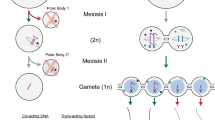Abstract
Meiotic pairing has now been shown to require heterochromatic homology and to be sensitive to repeat number in both male and female Drosophila. The increased pairing ability of repetitive sequences could be one reason that most eukaryotes allow the accumulation of tandem repeated elements. This may well be a reflection of a general role for heterochromatin, and at least a partial explanation of the ubiquity of heterochromatin through the eukaryotes.
Similar content being viewed by others
References
Gatti M, Pimpinelli S (1992) Functional elements in Drosophila melanogaster heterochromatin. Annu Rev Genet 26: 239
Grell RF (1976) Distributive pairing. In: Ashburner M, Novitski E (eds) The genetics and biology of Drosophila I a. Academic Press, New York, pp 435–486
Hawley RS, Irick H, Zitron AE, Haddox DA, Lohe A, New C, Whitley MD, Arbel T, Jang J, McKim K, Childs G (1993) There are two mechanisms of achiasmate segregation in Drosophila, one of which requires heterochromatic homology. Dev Genet 13: 440–467
Heitz E (1928) Das heterochromatin der Moose. Jahrb Wiss Bot 69: 762–818
Hilliker AJ, Holm DG, Appels R (1982) The relationship between heterochromatic homology and meiotic segregation of compound second autosomes during spermatogenesis in Drosophila melanogaster. Genet Res 39: 157–168
Holm DG (1976) Compound autosomes. In: Ashburner M, Novitski E (eds) The genetics and biology of Drosophila, Vol. 1B. Academic Press, London, pp 529–561
Holm DG, Chovnick A (1975) Compound autosomes in Drosophila melanopgaster: the meiotic behavior of compound thirds. Genetics 81: 293–311
McKee BD, Habera L, Verna JL (1992) Evidence that the intergenic spacer of Drosophila melanogaster rRNA genes function as X-Y pairing sites in male meiosis, and a general model for achiasmate pairing. Genetics 132: 529–544
McKee BD, Karpen G (1990) Drosophila ribosomal RNA genes function as an X-Y pairing site during male meiosis. Cell 61: 61–72
McKee BD, Lumsden SE, Das S (1993) The distribution of male meiotic pairing sites on chromosome 2 of Drosophila melanogaster: meiotic pairing and segregation of 2-Y transpositions. Chromosoma 102: 180–194
Morgan TH (1912) Complete linkage in the second chromosome of the male of Drosophila malanogaster. Science 36: 719–720
Novitski E (1964) An alternative to the distributive pairing hypothesis in Drosophila. Genetics 50: 1449–1551
Pardue ML, Hennig W (1990) Heterochromatin: junk or collectors item? Chromosoma 100: 3–7
Author information
Authors and Affiliations
Rights and permissions
About this article
Cite this article
Irick, H. A new function for heterochromatin. Chromosoma 103, 1–3 (1994). https://doi.org/10.1007/BF00364720
Received:
Accepted:
Issue Date:
DOI: https://doi.org/10.1007/BF00364720




